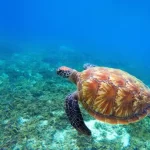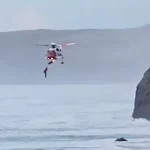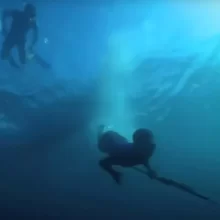NOAA Announces “Emergency Response” In Florida For Erratic Spinning Behavior Of Dying Sawfish
The post NOAA Announces “Emergency Response” In Florida For Erratic Spinning Behavior Of Dying Sawfish appeared first on Healthy Holistic Living.
In the tranquil waters of the Lower Florida Keys, a mysterious and troubling phenomenon has emerged, casting a shadow over the fate of the critically endangered smalltooth sawfish. Known for their distinctive saw-like snouts and formidable size, these marine creatures have begun displaying erratic spinning behaviors, accompanied by an alarming rate of unexplained deaths. This recent crisis has prompted an emergency response from the National Oceanic and Atmospheric Administration (NOAA) Fisheries, marking a significant moment in wildlife conservation efforts.
At the heart of this emergency lies not just the plight of the smalltooth sawfish, but a reflection of the broader challenges facing marine biodiversity. The situation underscores the fragility of critically endangered species and the complexity of factors threatening their survival. As conservationists and researchers rally to uncover the cause and mitigate the impact, the story of the smalltooth sawfish becomes a poignant call to action for environmental stewardship and a reminder of our interconnectedness with the natural world.
The Fight to Save Florida’s Prehistoric Smalltooth Sawfish
The smalltooth sawfish, a species that evokes the image of a creature straight out of prehistoric times, is facing an existential crisis in the Lower Florida Keys. Characterized by their elongated, saw-like rostrums lined with sharp teeth, these fish are not only a marvel of evolution but also a critical part of the marine ecosystem.
However, their unique existence is now threatened more than ever. Reports have emerged of smalltooth sawfish spinning and whirling uncontrollably in their natural habitat, accompanied by a series of unexplained deaths. This unusual situation has prompted NOAA Fisheries to declare an emergency response— a pioneering move aimed at addressing the dire situation facing these marine animals.
Various conservation organizations and aquariums are collaborating on an ambitious plan to rescue and rehabilitate affected sawfish in specialized quarantine facilities, setting it in motion. The agency, along with various conservation organizations and aquariums, has embarked on a groundbreaking mission to rescue and rehabilitate affected sawfish.
Adam Brame, the sawfish recovery coordinator at NOAA Fisheries, emphasized the gravity and novelty of this initiative. “This could be the first time we attempt to rescue and rehabilitate smalltooth sawfish from the wild,” he stated. The ultimate goal, according to Brame, is to “release all rescued sawfish back into the wild once they are deemed healthy.”
Behind the scenes, the challenge is daunting. As of late March, over a hundred sawfish have been affected by this mysterious condition, with the death toll reaching into the twenties. Given the smalltooth sawfish’s critically endangered status, each loss significantly hampers the species’ chances of recovery. The larger individuals, which play a pivotal role in the reproductive cycle, have been particularly affected.
A critical Situation
The latest data reveals a troubling toll on the smalltooth sawfish population, with 109 individuals affected by the mysterious condition, resulting in 28 confirmed fatalities. Notably, the impacted sawfish are predominantly large, spanning lengths of 2.1 to 4.3 meters (7 to 14 feet).
However, experts suspect that the actual mortality count might be higher, as sawfish, with their negative buoyancy, do not float after death. This discrepancy emphasizes the severity of the situation and the challenges in accurately assessing its full impact.
Adam Brame, a key figure in the conservation efforts, stresses the significance of even minor losses. “The loss of even two dozen sawfish is significant,” he emphasizes, shedding light on the potential ramifications for the species’ recovery. Given their critically endangered status, each casualty further burdens the already dwindling population of smalltooth sawfish.
Decoding the Marine Mystery
The sudden and mysterious affliction striking the smalltooth sawfish has puzzled scientists and conservationists alike. With each passing day, the urgency to identify the cause and implement effective solutions grows. The Florida Fish and Wildlife Conservation Commission, alongside NOAA Fisheries, has been at the forefront of these efforts, conducting extensive necropsies in hopes of uncovering any clues.
However, the results have thus far been inconclusive, with no evidence pointing towards infections, pollution, toxic algae blooms, or issues related to low oxygen levels in the water. This lack of definitive answers only compounds the complexity of the challenge at hand.
Water quality tests continue in a bid to rule out or identify environmental factors that could be contributing to the sawfish’s distress. Among the myriad possibilities, climate change emerges as a formidable suspect. The record-breaking seawater temperatures recorded in South Florida last year, which in some instances reached as high as 38.3°C (101°F), mirror the conditions of a hot bath, creating a hostile environment for marine life.
Such extreme temperatures could have profound effects on the physiological and behavioral patterns of marine species, including the smalltooth sawfish. The link between these unprecedented climate conditions and the sawfish’s erratic behavior, while not yet confirmed, presents a critical area of investigation.
Efforts to save the sawfish are not limited to diagnosis and research. Conservationists are also exploring innovative solutions to rescue and rehabilitate distressed individuals, with hopes of returning them to their natural habitat. This initiative, while challenging, reflects a broader commitment to marine conservation and the preservation of biodiversity. By understanding the factors that threaten the smalltooth sawfish, conservationists aim not only to save this particular species but also to gain insights that could help protect other marine creatures facing similar threats.
The Critical Role of Sawfish in Marine Ecosystems
The smalltooth sawfish, scientifically known as Pristis pectinata, is a remarkable creature. Its most distinctive feature is its saw-like snout, lined with sharp, transverse teeth. This unique adaptation is not just for defense but also plays a crucial role in hunting. The saw helps them navigate and unearth food from the sediment-laden seabeds and emits an electrical field to detect prey. These sawfish belong to the subclass Elasmobranchii, which they share with sharks, rays, and skates.
Understanding the ecological significance of the smalltooth sawfish illuminates the urgency behind the efforts to save them. As apex predators, sawfish play a crucial role in maintaining the health and balance of the marine ecosystems they inhabit. Their presence helps regulate the populations of smaller fish and crustaceans, preventing any single species from dominating the environment and altering its composition. This balance is essential for the health of coral reefs and seagrass beds, which provide habitat for a myriad of marine life and contribute to the overall biodiversity of the ocean.
The unique morphology of the sawfish, particularly their saw-like rostrum, is not just an evolutionary marvel but also a tool that enhances their role in the ecosystem. They use it to stir the seabed, uncovering prey and facilitating the aeration of the sediment. This activity is beneficial for other marine organisms, promoting a healthy and dynamic underwater landscape. Additionally, the electrical sensors located along their rostrum allow them to detect prey in the murky waters, highlighting their adaptation to diverse marine environments.
Conservation Strategies for the Smalltooth Sawfish in Florida
Amidst the dire situation facing the smalltooth sawfish, a multifaceted conservation strategy has been deployed, showcasing the innovative approaches being taken to protect and preserve this critically endangered species. At the core of this strategy lies the emergency response initiative led by NOAA Fisheries, which encompasses rescue, rehabilitation, and, ultimately, the release of affected sawfish back into their natural habitats. This approach is pioneering in its attempt to directly intervene in the lives of these wild creatures, thus setting a new precedent for conservation efforts worldwide.
From Rescue to Rebirth
Rescue Efforts: The initial phase involves the careful and humane capture of distressed sawfish showing erratic behaviors or those found in areas with high mortality rates. These efforts require coordination among conservationists, local communities, and volunteers, ensuring minimal stress and harm to the animals during the process.
Rehabilitation Process: Once rescued, the sawfish are transported to specialized quarantine facilities designed to mimic their natural environment as closely as possible. Here, they receive medical treatment, if necessary, and are closely monitored by marine biologists and veterinarians. The rehabilitation process focuses on allowing the sawfish to recover from their ailments and regain their strength, preparing them for eventual re-release into the wild.
Release and Monitoring: The final step in the conservation strategy is the careful release of rehabilitated sawfish back into their natural habitats. Researchers often use tracking devices to monitor the movements, behavior, and survival of the sawfish, providing valuable data that can inform future conservation efforts. The goal is to ensure that these animals can reintegrate into their ecosystems and contribute to the natural breeding population, bolstering the overall numbers of the species.
This comprehensive approach underscores the complexity and challenges of marine conservation, especially when dealing with critically endangered species like the smalltooth sawfish. It also reflects a growing recognition of the importance of direct intervention and the use of science and technology in conservation efforts. As these strategies continue to evolve, they offer hope not only for the smalltooth sawfish but for countless other species facing similar threats to their survival.
A Call to Action for Marine Conservation
The crisis facing the smalltooth sawfish in the Lower Florida Keys is a stark reminder of the fragile state of our planet’s biodiversity and the critical need for comprehensive conservation efforts. While the emergency response by NOAA Fisheries and its partners offers a glimmer of hope for this critically endangered species, the underlying issues threatening marine life worldwide—such as climate change, habitat destruction, and pollution—require global attention and action.
Engaging the Public in Conservation: Public awareness and involvement are vital components of successful conservation. By educating communities about the importance of marine ecosystems and the threats they face, we can inspire collective action and support for conservation initiatives. This includes promoting sustainable fishing practices, reducing plastic pollution, and supporting protected marine areas.
Supporting Research and Innovation: Continued investment in scientific research is crucial for understanding the complexities of marine ecosystems and the specific needs of endangered species like the smalltooth sawfish. Innovation in conservation technologies, such as tracking and monitoring devices, can enhance our ability to protect and preserve these species for future generations.
Advocating for Stronger Policies: Advocacy for stronger environmental protection policies at both the national and international levels is essential to safeguard marine biodiversity. This includes enforcing regulations on commercial fishing, protecting critical habitats, and addressing the root causes of climate change.
Fostering International Collaboration: By sharing research, resources, and best practices, countries can work together to create a unified strategy against the threats to marine biodiversity. Collaborative efforts, such as international treaties and agreements focused on the protection of endangered species and their habitats, can play a pivotal role in ensuring the survival of species at risk. Through a concerted global effort, we can address the systemic issues affecting our oceans and work towards a more sustainable and biodiverse future.
Charting a Course of Hope for Florida’s Smalltooth Sawfish
The crisis gripping the smalltooth sawfish in the serene waters of the Lower Florida Keys serves as a poignant reminder of the fragility of our marine ecosystems. As NOAA Fisheries spearheads an emergency response to rescue and rehabilitate these iconic creatures, it marks a pivotal moment in wildlife conservation.
The plight of the smalltooth sawfish is a call to action for everyone—from policymakers and scientists to local communities and individuals. By working together, we can turn the tide for endangered species and ensure the health and vitality of our planet’s oceans. The story of the smalltooth sawfish is not just a tale of crisis; it’s a story of hope, resilience, and the power of concerted conservation efforts to make a difference.
In the face of adversity, conservationists, researchers, and communities unite in a multifaceted effort to protect these majestic creatures. From innovative rescue missions to advocating for stronger environmental policies, the fight to save the smalltooth sawfish is a testament to human ingenuity and compassion.
As we navigate the uncertainties of the present, the story of the smalltooth sawfish offers a beacon of hope. It is a reminder that through collective action and unwavering determination, we can overcome even the most daunting challenges and safeguard the rich tapestry of life that thrives beneath the waves.
The post NOAA Announces “Emergency Response” In Florida For Erratic Spinning Behavior Of Dying Sawfish appeared first on Healthy Holistic Living.












